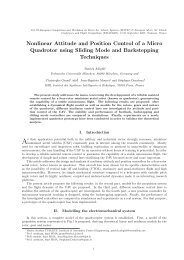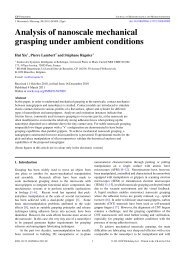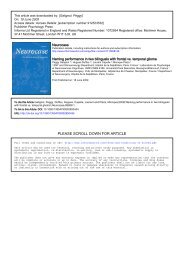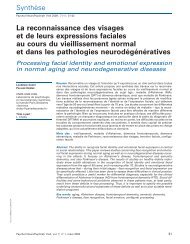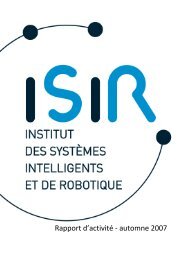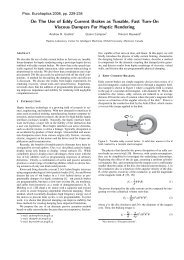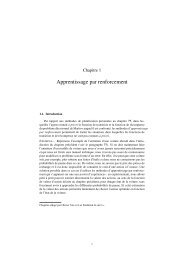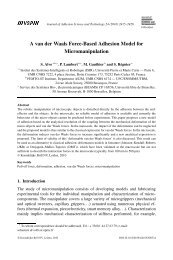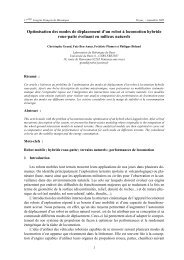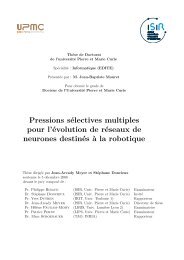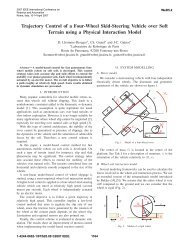The Pantograph Mk-II: A Haptic Instrument - CIM - McGill University
The Pantograph Mk-II: A Haptic Instrument - CIM - McGill University
The Pantograph Mk-II: A Haptic Instrument - CIM - McGill University
You also want an ePaper? Increase the reach of your titles
YUMPU automatically turns print PDFs into web optimized ePapers that Google loves.
Proc. IROS 2005, IEEE/RSJ Int. Conf. Intelligent Robots and Systems, pp. 723-728.<br />
3) <strong>The</strong> device should incorporate a source of calibrated<br />
viscous damping [5], something which is the subject of<br />
on-going work.<br />
4) “Bell coreless” motors work well but are less than<br />
ideal for haptic device applications due to (1) their<br />
sharp internal resonance characterized in this paper,<br />
and (2) use of un-needed brushes in a limited angle<br />
application [24]. Motors having an absence of torque<br />
ripple, absence of cyclical reluctant torque (cogging),<br />
optimized structural properties, and absence of friction<br />
(in addition to high torque, of course) should be designed<br />
specifically for this application. Recent proposals<br />
for electronic compensation of the injurious properties<br />
of motors designed for other purposes fall short of our<br />
requirements in this respect [16].<br />
Finally, we hope to be able to release the system publicly<br />
in a near future, even if not all the points discussed above are<br />
fully addressed. At the present time however, the system is<br />
in use to carry out studied in high fidelity friction and texture<br />
synthesis techniques [3], [11].<br />
ACKNOWLEDGMENTS<br />
Qi Wang and Gianni Campion thank PRECARN Inc. for<br />
scholarships. <strong>The</strong> authors would also like to thank Hsin-<br />
Yun Yao for assistance in PCB design and manufacturing and<br />
Andrew Havens Gosline for insightful comments on an earlier<br />
draft of this paper.<br />
REFERENCES<br />
[1] B. D. Adelstein and M. J. Rosen. Design and implementation of a<br />
force reflective manipulandum for manual control research. In Proc.<br />
Advances in Robotics, ASME Winter Annual Meeting, volume DSC-42,<br />
pages 1–12, 1992.<br />
[2] P. Buttolo and B. Hannaford. Advantages of actuation redundancy for<br />
the design of haptic-displays. In Proc. ASME Fourth Annual Symposium<br />
on <strong>Haptic</strong> Interfaces for Virtual Environments and Teleoperator<br />
Systems, volume DSC-57-2, pages 623–630, 1995.<br />
[3] G. Campion and V. Hayward. Fundamental limits in the rendering of<br />
virtual haptic textures. In Proc. World<strong>Haptic</strong>s Conference 2005, pages<br />
263–270, 2005.<br />
[4] M.C. Cavusoglu, D. Feygin, and F. Tendick. A critical study of<br />
the mechanical and electrical properties of the PHANToM haptic<br />
interface and improvements for high performance control. Presence:<br />
Teleoperators and Virtual Environments, 11(6):555–568, 2002.<br />
[5] J. E. Colgate and G. G. Schenkel. Passivity of a class of sampleddata<br />
systems: application to haptic interfaces. J. of Robotic Systems,<br />
14(1):37–47, 1997.<br />
[6] D. DiFilippo and D. K. Pai. <strong>The</strong> AHI: An audio and haptic interface for<br />
contact interactions. In Proc. UIST’00, 13th Annual ACM Symposium<br />
on User Interface Software and Technology, 2000. available online<br />
http://www.acm.org/uist/uist2000/fp.main.html.<br />
[7] R. E. Ellis, O. M. Ismaeil, and M. Lipsett. Design and evaluation of<br />
a high-performance prototype planar haptic interface. In Proc. ASME<br />
Advances in Robotics, Mechatronics, and <strong>Haptic</strong> Interfaces, volume<br />
DSC-9, pages 55–64, 1993.<br />
[8] R. Fletcher. Practical Methods of Optimization. John Wiley & Sons,<br />
1987.<br />
[9] D. Grant. Two new commercial haptic rotary controllers. In Proc.<br />
Eurohaptics, page 451, 2004.<br />
[10] C. J. Hasser and M. R. Cutkosky. System identification of the human<br />
hand grasping a haptic knob. In Proc. 10th Symposium on <strong>Haptic</strong><br />
Interfaces for Virtual Environment and Teleoperator Systems (HAPTICS<br />
’02), 2002.<br />
[11] V. Hayward and B. Armstrong. A new computational model of<br />
friction applied to haptic rendering. In P. Corke and J. Trevelyan,<br />
editors, Experimental Robotics VI, pages 403–412. Springer Verlag,<br />
2000. Lecture Notes in Control and Information Sciences 250.<br />
[12] V. Hayward and O. R. Astley. Performance measures for haptic<br />
interfaces. In G. Giralt and G. Hirzinger, editors, Robotics Research:<br />
<strong>The</strong> 7th International Symposium, pages 195–207. Springer Verlag,<br />
1996.<br />
[13] V. Hayward, J. Choksi, G. Lanvin, and C. Ramstein. Design and multiobjective<br />
optimization of a linkage for a haptic interface. In J. Lenarcic<br />
and B. Ravani, editors, Advances in Robot Kinematics, pages 352–359.<br />
Kluver Academic, 1994.<br />
[14] V. Hayward, P. Gregorio, O. Astley, S. Greenish, M. Doyon, L. Lessard,<br />
J. McDougall, I. Sinclair, S. Boelen, X. Chen, J.-P. Demers, J. Poulin,<br />
I, Benguigui, N. Almey, B. Makuc, and X. Zhang. Freedom-7: A high<br />
fidelity seven axis haptic device with application to surgical training.<br />
In A. Casals and A. T. de Almeida, editors, Experimental Robotics V,<br />
pages 445–456. Springer Verlag, 1998. Lecture Notes in Control and<br />
Information Science 232.<br />
[15] Quanser Inc. 3-DOF planar <strong>Pantograph</strong>. In Quanser Product Information,<br />
2004. http://www.quanser.com.<br />
[16] D. A. Lawrence, L. Y. Pao, A. C. White, and W. Xu. Low cost<br />
actuator and sensor for high-fidelity haptic interfaces. In Proc. 12th<br />
International Symposium on <strong>Haptic</strong> Interfaces for Virtual Environment<br />
and Teleoperator Systems (HAPTICS’04), pages 74–81, 2004.<br />
[17] J. McDougal, L. B. Lessard, and V. Hayward. Applications of advanced<br />
materials to robotic design: <strong>The</strong> freedom-7 haptic hand controller.<br />
In Proc. Eleventh International Conference on Composite Materials<br />
(ICCM-11), 1997.<br />
[18] T. E. Milner and D. W. Franklin. Characterization of multijoint finger<br />
stiffness: Dependence on finger posture and force direction. IEEE T.<br />
on Biomedical Engineering, 45(11):1363–1375, 1998.<br />
[19] M. Moreyra and B. Hannaford. A practical measure of dynamic<br />
response of haptic devices. In Proc. IEEE International Conference<br />
on Robotics and Automation, pages 369–374, 1998.<br />
[20] J. B. Morrell and J. K. Salisbury. Performance measurements for robotic<br />
actuators. In Proc. ASME Dynamics Systems and Control Division,<br />
volume DSC-58, pages 531–537, 1996.<br />
[21] J. Murayama, L. Bougrila, Y.L. Luo, K. Akahane, S. Hasegawa,<br />
B. Hirsbrunner, and M. Sato. Spidar G&G: A new two-handed haptic<br />
interface for bimanual VR interaction. In Proc. Eurohaptics, pages<br />
138–146, 2004.<br />
[22] C. Ramstein and V. Hayward. <strong>The</strong> <strong>Pantograph</strong>: A large workspace<br />
haptic device for a multi-modal human-computer interaction. In Proc.<br />
CHI’94, Conference on Human Factors in Computing Systems, pages<br />
57–58. ACM/SIGCHI Companion-4/94, 1994.<br />
[23] L. Rosenberg. How to assess the quality of force-feedback systems. J.<br />
of Medicine and Virtual Reality, 1(1):12–15, 1995.<br />
[24] S. E. Salcudean and L. Stocco. Isotropy and actuator optimization in<br />
haptic interface design. In Proc. IEEE International Conference on<br />
Robotics & Automation, pages 3107–3113, 2000.



